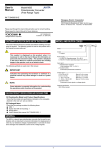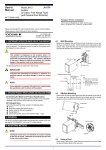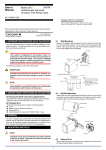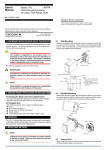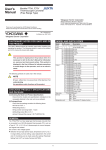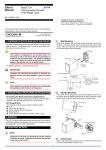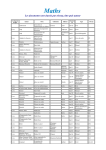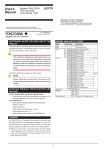Download User`s Manual
Transcript
User’s Manual Model MA5D Distributor (2-output, Free Range Type) IM 77J04A05-02E Network Solutions Business Division 2-9-32, Naka-cho Musashino-shi, Tokyo 180-8750 Japan Phone: +81-422-52-7179 Facsimile: +81-422-52-6793 Please read through this User’s Manual before use for correct handling. Please keep this User’s Manual for future reference. IM 77J04A05-02E 1st Edition Jul. 2005 (YK) CAUTIONARY NOTES FOR SAFE USE OF THE PRODUCT MODEL AND SUFFIX CODES This User’s Manual should be carefully read before installing and operating the product. The following symbol is used on the product and in this manual to ensure safe use. MA5D - 2 -A Model Type 0: General use 1: MA1W, MA6W type (same as the MA1W, MA6W terminal assignments) This symbol is displayed on the product when it is necessary to refer to the User’s Manual for information on personnel and instrument safety. This symbol is displayed in the User’s Manual to indicate precautions for avoiding danger to the operator, such as an electric shock. Output 2: 2 outputs Power supply 1: 15-40 V DC (Operating range: 12 to 48 V) 6: 100-240 V AC/DC (Operating range: 85 to 264 V) The following symbols are used only in this manual. IMPORTANT Input signal A: 4 to 20 mA DC Indicates that operating the hardware or software in a particular manner may cause damage or result in a system failure. Output-1 signal A: 0 to 20 mA DC Span is 5 mA or more B: 0 to 5 mA DC Span is 1 mA or more 1: −10 to +10 V DC Span is 0.1 V or more 2: −100 to +100 mV DC Span is 10 mV or more Z: (Custom order) Customized current signals or voltage signals NOTE Draws attention to essential information for understanding the operations and/or functions of the product. Output-2 signal A: 4 to 20 mA DC 1: 0 to 10 mV DC B: 2 to 10 mA DC 2: 0 to 100 mV DC C: 1 to 5 mA DC 3: 0 to 1 V DC D: 0 to 20 mA DC 4: 0 to 10 V DC E: 0 to 16 mA DC 5: 0 to 5 V DC F: 0 to 10 mA DC 6: 1 to 5 V DC G: 0 to 1 mA DC 7: −10 to +10 V DC Z: (Custom order) Customized current signals or voltage signals CHECKING PRODUCT SPECIFICATIONS AND PACKAGED ITEMS (1) Checking the Model and Product Specifications Check that the model and specifications indicated on the nameplate attached to the main unit are as ordered. (2) Packaged Items Check that the package contains the following items: ● MA5D: 1 ● Spacer (for DIN rail mounting): 1 ● Range label: 1 ● User’s Manual (this manual: IM 77J04A05-02E): 1 Breakpoint linearization 0: Not available 1: Available Optional specification /SN: Without socket GENERAL This plug-in type distributor is used in combination with a two-wire type transmitter to convert the transmitter’s 4 to 20 mA DC signals into DC current or DC voltage signals. 1 / 1. MOUNTING METHOD 2. INSTALLATION LOCATIONS ● Avoid the following environments for installation locations: Areas with vibration, corrosive gases, dust, water, oil, solvents, direct sunlight, radiation, a strong electric field, and/or a strong magnetic field Installation altitude: 2000 m or less above sea level. ● If there is any risk of a surge being induced into the power line and/or signal lines due to lightning or other factors, a dedicated lightning arrester should be used as protection for both this distributor and a field-installed device. ● Operating temperature/humidity range: 0 to 50C/5 to 90%RH (no condensation) NOTE Plug/disconnect the main unit into/from the socket vertically to the socket face. Otherwise the terminals may bend and it may cause bad contact. 1.1 Wall Mounting Unfasten the upper and lower stoppers of the distributor to disconnect the main unit from the socket. Next, anchor the socket onto the wall with two M4 screws. Then, plug the main unit into the socket and secure the main unit with the upper and lower stoppers. 3. EXTERNAL WIRING Stopper WARNING To avoid the risk of an electric shock, turn off the power supply and use a tester or similar device to ensure that no power is supplied to a cable to be connected, before carring out wiring work. Main unit Socket Mounting screws [Mounting Dimensions] Pitch: 56 or more Unit: mm 5 or more Socket Wires are connected to the terminals of the distributor’s socket. M3.5 screw terminals are provided for the connection of external signals. Attach a crimp-on lug to each wire for connection to the terminals. ● Recommended cables: A nominal cross-sectional area of 0.5 mm2 or thicker for signal cables, and that of 1.25 mm2 or thicker for power cables. (85) 2-4.5 or 2-M4 MA5D - 02 Note: • When mounting the units close together, leave a space of at least 5 mm between them. • Use the supplied spacer to keep a space of 5 mm for DIN rail mounting. Power supply Input L+ 7 PS+ + N− 8 GND 8 7 6 5 − PS+ + 4 – + 5 − 400.2 (51) 9 Output-2 DIN Rail Mounting 10 Locate the distributor so that the DIN rail fits into the upper part of the DIN-rail groove at the rear of the socket, and fasten the socket using the slide lock at the lower part of the socket. 11 + 3 10 11 − 5 1 2 6 COM -A When using internal power supply PS+ Output-1 1 2 DIN rail MA5D - 12 6 − Fit into here + + − 6 – 5 − IMPORTANT ● The power line and input/output signal lines should be installed away from noise-generating sources. Other wise accuracy cannot be guaranteed. ● The grounding resistance must be 100 Ω (JIS Class D grounding). The length and thickness of the grounding cable should be as short and thick as possible. Directly connect the lead from the ground terminal (terminal no. 9) of the product to the ground. Do not carry out daisychained inter-ground terminal wiring. ● Use of the product ignoring the specifications may cause overheating or damage. Before turning on the power, ensure the following: (a) Power supply voltage and input signal value applied to the product should meet the required specifications. (b) The external wiring to the terminals and wiring to ground are as specifications. ● Do not operate the product in the presence of flammable or explosive gases or vapors. To do so is highly dangerous. ● The product is sensitive to static electricity; exercise care in operating it. Before you operate the product, touch a nearby metal part to discharge static electricity. Push DIN rail (Rear of socket) Spacer Slide lock 1.3 5 4 – 9 4 1.2 -A When using When using Example to construct internal external Intrinsically Safe System power supply power supply using Zener Barrier Using Ducts Wiring ducts should be installed at leaset 30 mm away from the top or bottom of the main unit. 2 IM 77J04A05-02E 1st Edition Jul 29, 2005-00 Power Supply and Isolaion 4.3 Selection Switch and Adjustment Switch Power supply rated voltage: 15-40 V DC or 100-240 V AC/DC 50/60 Hz Power supply input voltage: 15-40 V DC (±20%) or 100-240 V AC/DC (−15, +20%) 50/60 Hz Power consumption: 24 V DC 3.5 W, 110 V DC 3.4 W 100 V AC 6.5 VA, 200 V AC 8.7 VA Insulation resistance: 100 MΩ at 500 V DC between input, output, power supply, and grounding terminals mutually. Withstand voltage: 2000 V AC for 1 minute between input, output, power supply and grounding terminals mutually. 1000 V AC for 1 minute between output-1 and output-2 terminals. The following adjustments can be performed using the switches on the front panel (selection switch and adjustment switch) without the dedicated setting tool (refer to “4.2 Connector for Communication”). The adjusted value is saved about 1 second after operating the adjustment switch. Also when the rotation direction of the adjustment switch is changed, the adjusted value becomes effective about 1 second after the change. Position of selection switch 0 1 2 3 4 5 6 Rotation direction of adjustment switch Adjustment operation Increase of output adjusted value and Clockwise adjustment of input Decrease of output adjusted value and Counterclockwise reset of input adjusted value 4. DESCRIPTION OF FRONT PANEL The figure below shows the distributor of which the front panel cover is open. Connector for communication [Adjusted volume by the adjustment switch] One click changes about 0.005% of the output range. Operation indicating lamp: Turns on at power on. Selection switch 4.3.1 Adjusting Output Using the Switches on the Front Panel Adjustment switch (1) Output-1 zero adjustment Apply the 0% input signal. Turn the selection switch to “1.” Then turn the adjustment switch clockwise to increase the output, or turn it counterclockwise to decrease the output. (2) Output-1 span adjustment Apply the 100% input signal. Turn the selection switch to “2.” Then turn the adjustment switch clockwise to increase the output, or turn it counterclockwise to decrease the output. Output-2 can be adjusted by the same operation as the above. (3) Output-2 zero adjustment Apply the 0% input signl. Turn the selection switch to “3.” Use the adjustment switch for adjustment. (4) Output-2 span adjustment Apply the 100% input signal. Turn the selection switch to “4.” Use the adjustment switch for adjustment. 4.1 Operation Indicating Lamp The operation indicating lamp shows the operation status, abnormalities in a setting, and adjustment operation status by the adjustment switch on the front panel. (1) When the lamp is lit: Power is turned on and the distributor is in the normal status provided that the selection switch is set to the position “0.” (2) When the lamp is blinking rapidly: The lamp repeats the rapid blinking until the internal processing is completed during I/O adjustments by the adjustment switch. (3) When the lamp is blinking slowly: The lamp repeats the slow blinking until the distributor regains its normal status when the following abnormalities occur. • Abnormalities in a parameter setting • The selection switch is set to the positions other than “0.” • Input is outside of the range of −10 to 110%. 4.3.2 Adjusting Input Using the Switches on the Front Panel When performing the zero/span adjustment of input, be sure to turn the adjustment switch counterclockwise to reset the adjusted value at first. (1) Input zero adjustment Apply the 0% input signal. Turn the selection switch to “5.” Then turn the adjustment switch clockwise to adjust the input read value, or turn it counterclockwise to reset the adjusted value. (2) Input span adjustment Apply the 100% input signal. Turn the selection switch to “6.” Then turn the adjustment switch clockwise to adjust the input read value, or turn it counterclockwise to reset the adjusted value. 4.2 Connector for Communication Use the connector for communication when setting the parameters using a PC (VJ77 Parameter Setting Tool) or the Handy Terminal. < How to connect with the setting tool> JHT200 Handy Terminal Item to be adjusted No function Output-1 zero adjustment Output-1 span adjustment Output-2 zero adjustment Output-2 span adjustment Input zero adjustment Input span adjustment NOTE JUXTA communication cable with 5-pin connector (F9182EE) [Provided with VJ77 and JHT200] ● Be sure to set the selection switch back to the position “0” after each adjustment. Otherwise it may cause an incorrect operation or malfunction because the positions other than “0” are adjustment modes. ● When the selection switch is set to the positions other than “0”, the setting tool can not be used for the setting. Modular jack conversion adapter (E9786WH) [Provided with VJ77] Dedicated adapter (E9789HA) [Provided with VJ77] Dedicated cable (E9786WK) [Provided with VJ77] PC which is installed with the VJ77. *: Use the VJ77 of version R1.04 or later. 3 IM 77J04A05-02E 1st Edition Jul 29, 2005-00 5. SETTING PARAMETERS 6. Set the parameters using a PC (VJ77 Parameter Setting Tool) or the Handy Terminal. Refer to “6. List of Parameters” in this manual and the User’s Manual for VJ77 PC-based Parameters Setting Tool (IM 77J01J77-01E) or the User’s Manual for JHT200 Handy Terminal (IM JF81-02E). Parameters are indicated inside the [ ]. 5.1 Parameter Display MODEL TAG NO SELF CHK A DISPLAY1 A01 INPUT1 A07 OUTPUT1 A08 OUTPUT2 A54 STATUS A56 REV NO A58 MENU REV A60 SELF CHK B DISPLAY2 B01 INPUT1 B07 OUTPUT1 B08 OUTPUT2 B60 SELF CHK D SET (I/O) D01 TAG NO.1 D02 TAG NO.2 D03 COMMENT1 D04 COMMENT2 D14 LINEARIZE D15 LOW CUT D38 OUT1 L_RNG D39 OUT1 H_RNG D40 OUT2 L_RNG D41 OUT2 H_RNG D49 OUT1 DR D50 OUT2 DR D60 SELF CHK M X TABLE M01 X TABLE M02 X TABLE : : M31 X TABLE M32 X TABLE M33 MAX POINT M60 SELF CHK N Y TABLE N01 Y TABLE N02 Y TABLE : : N31 Y TABLE N32 Y TABLE N60 SELF CHK P ADJUST P08 IN1 ZERO ADJ P09 IN1 SPAN ADJ P26 OUT1ZERO ADJ P27 OUT1SPAN ADJ P28 OUT2ZERO ADJ P29 OUT2SPAN ADJ P60 SELF CHK Q TEST Q03 OUT1 TEST Q04 OUT2 TEST Q60 SELF CHK Setting Square Root Extractor Set “with square root extractor” or “without square root extractor” in [D14: LINEARIZE]. “SQR” for “with square root extractor” and “OFF” for “without square root extractor.” 5.2 Setting Lowcut Point Set a numeric value in [D15:LOW CUT] when “with square root extractor” is selected. ● Setting range: 0.3 to 100% of the input range (setting resolution: 0.1%) Output signal (Y) Y=X 0 Hysteresis (approx. 0.2% fixed) 5.3 Input signal (X) Lowcut point Setting Breakpoint Linearization (1) Set the breakpoint linearization in [D14: LINEARIZE]. Select “ON” to use the breakpoint linearization. Select “OFF” not to use the breakpoint linearization. (2) Set the breakpoints data. Set the input breakpoints data in [M01: X TABLE] to [M32: X TABLE]. Set the number of breakpoints data in [M33: MAX POINT]. Set the output breakpoints data in [N01: Y TABLE] to [N32: Y TABLE]. ● Setting condition of breakpoints data Maximum number of breakpoints: 32 Setting range: −6 to 106% (both input and output) • Set a relationship between the input and outpout at % value to the span. • With 4 significant digits; can be set to the second place of a decimal point. • For input: −6.00X0X1X2…Xn-1Xn106.0% • For output: −6.00Y0Y1 to Yn106.0% 5.4 LIST OF PARAMETERS Setting Output-1 Range Set the 0% value of output-1 range in [D38: OUT1 L_RNG] and the 100% value of output-1 range in [D39: OUT1 H_RNG]. NOTE Changing the output-1 range resets the adjusted value. Item Model Tag number Self-check result Display1 Input-1 Output-1 Output-2 Status *1 REV No. MENU REV Self-check result Display2 Input-1 Output-1 Output-2 Self-check result Setting (I/O) Tag number-1 Tag number-2 Comment-1 Comment-2 Linearization Lowcut point *2 Output-1 low range Output-1 high range Output-2 low range *3 Output-2 high range *3 Direction of output-1 action Direction of output-2 action Self-check result Input breakpoint table Input breakpoints data Input breakpoints data : Input breakpoints data Input breakpoints data Number of breakpoints Self-check result Output breakpoint table Output breakpoints data Output breakpoints data : Output breakpoints data Output breakpoints data Self-check result Adjustment Input-1 zero adjustment Input-1 span adjustment Output-1 zero adjustment Output-1 span adjustment Output-2 zero adjustment Output-2 span adjustment Self-check result Test Forced output-1 Forced output-2 Self-check result *1 The displayed status is to let the service staff know the past records of the product. *2 The parameter becomes effective when "SQR" is selected in [D14:LINEARIZE]. *3 The parameters are the items to be set at the factory. 4 IM 77J04A05-02E 1st Edition Jul 29, 2005-00 7. MAINTENANCE The product starts running immediately when the power is turned on; however, it needs 10 to 15 minutes of warm-up before it meets the specified performance. 7.1 ● ● ● ● 7.2 Calibration Apparatus A DC voltage/current standard (Yokogawa 7651 or the equivalent) A digital mutimeter (Yokogawa 7561 or the equivalent) A precision resistor of 250 Ω ± 0.01%, 1 W A setting tool for adjustment (Refer to “ 4.2 Connector for Communication” in this manual.) Calibration Procedure (1) Connect the instruments as shown below. First adjust the output-1 signal and then the output-2 signal. (2) Use the DC voltage/current standard and apply input signals equivalent to 0, 25, 50, 75, and 100% of input span to the distributor. When “with square root extractor” is selected, apply input signals equivalent to 0, 6.25, 25, 56.25, and 100% of input span to the distributor. (3) Check to see the corresponding output voltages are 0, 25, 50, 75, and 100% respectively and within the specified accuracy rating. “R” is used for current output. ● Use the setting tool (VJ77 Parameter Setting Tool or JHT200 Handy Terminal) or the switches on the front panel (selection switch and adjustment switch) to adjust the input/output signals. Input Adjustment Procedure (1) Input the value equivalent to 0% value of input range. (2) Call the display item (A: DISPLAY1) to check the input value in A01: INPUT1. (3) If the adjustment is necessary, call the adjustment item (P: ADJUST). (4) Select P08: IN1 ZERO ADJ to enter the adjustment mode. Select EXECUTE (adjustment) for adjustment. (If RESET is selected, the adjusted value is reset to the factory-set default.) (5) Input the value equivalent to 100% value of input range. (6) Call the display item (A: DISPLAY1) to check the input value in A01: INPUT1. (7) If the adjustment is necessary, call the adjustment item (P: ADJUST). (8) Select P09: IN1 SPAN ADJ to enter the adjustment mode. Select EXECUTE (adjustment) for adjustment. (If RESET is selected, the adjusted value is reset to the factory-set default.) Output Adjustment Procedure (1) When adjusting 0% value of output-1, call the adjustment item (P: ADJUST) to select P26: OUT1ZERO ADJ. (2) If it slips out to (+) side, set (−) value equivalent to slipout; if slips out to (−) side, set (+) value equivalent to slipout. *: The 100% value of output-1 and the 0% value and 100% value of output-2 can be adjusted by the same operation as the above. For adjustment using a setting tool, refer to the User’s Manual for each setting tool and “6. List of Parameters” in this manual. For adjustment using the switches on the front panel, refer to “4.3 Selection Switch and Adjustment Switch.” User’s Manual for VJ77 [Document No.: IM 77J01J77-01E]; however, use the VJ77 of version R1.04 or later. User’s Manual for JHT200 [Document No.: IM JF81-02E] Input MA5D - 02 -A With SINK current Power supply 4 + DC voltge/ 5 − standard current L+ 7 N− Without SINK current 8 8 GND 7 6 5 9 4 9 + R 11 − + DC voltge/ 6 − standard current 3 MA5D - 12 Output-2 10 5 10 11 1 2 Digital multimeter -A With SINK current 6 + DC voltge/ 5 − standard current R: 250 Ω precision resistor for current output Output-1 + 1 R 2 − Digital multimeter R: 250 Ω precision resistor for current output 5 IM 77J04A05-02E 1st Edition Jul 29, 2005-00 6 IM 77J04A05-02E 1st Edition Jul 29, 2005-00










